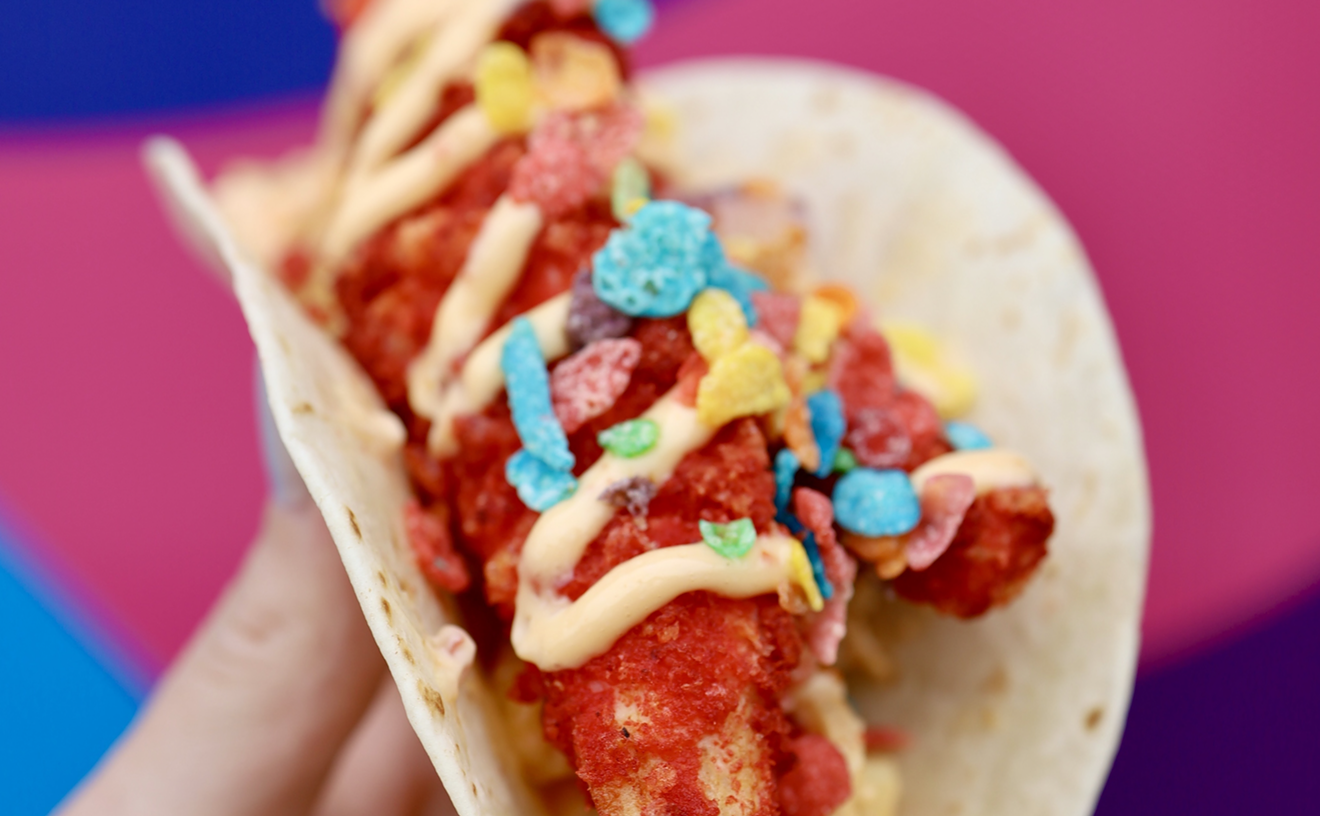At his Brickell noodle house, Momi Ramen, which opened in December, Jeffrey Chen ties a black bandanna printed with white skulls tightly across his scrunched forehead. He works silently behind a glass panel. Around him, Miami's food cognoscenti, huddled about wooden tables, hover above bowls of soup. For years, these noodle lovers have waited for a ramen house to open in the Magic City. So the setting is quiet. Only the twiddle of chopsticks and the slurping of noodles can be heard.
Chen never looks up, and he rarely speaks. He is too busy overseeing massive kettles of rich tonkotsu — a silky, opaque broth, simmered low and slow, made with pork bones and topped with gleaming, oleaginous globs of fat. Its perfume, permeating the air with murky notes of jowl and garlic, jolts me as I step into the petite eatery. Momi is a house of ramen, but it is also a center of worship for devotees of noodle and broth.
I select a bowl of the vegetarian shoyu ramen — a soy-based broth topped with the chef's choice of vegetables. The waitress, decked out in rubber boots and a miniskirt, asks if I'm vegetarian. She doesn't wait for an answer. "I want to switch the shoyu for a tonkotsu broth. It goes better with the vegetables," she says.
I nod and she is gone.
Soon my bowl arrives. The basin holds a delectable, tawny broth with notes of pork and toppings such as enoki mushrooms and scallions. Ramen is to be enjoyed quickly, while the broth is steaming and the noodles are slightly firm. At Momi, aromatic broths and springy noodles encourage many empty bowls.
Nearby, I hear a hopeful guest ask whether there is dessert on the menu. The waitress smirks. "No. The owner says his ramen is already too much work."
Other cities, such as New York and Los Angeles, have been home to ramen eateries for more than a decade, but in Miami, the restaurants have been few and far between. So it was encouraging when both Momi Ramen and Machiya, a handsome 140-seater in midtown, debuted here in the latter part of 2012. Both were marketed as ramen restaurants. They would concentrate on what other establishments, such as Buena Vista's Shokudo and Bal Harbour's Makoto, had been offering as part of a more diverse menu.
Makoto, Shokudo, and Machiya all purchase noodles from a supplier. Makoto Okuwa, the toque behind his eponymous Bal Harbour spot, says it would be financially irresponsible to make noodles fresh. Prepared with flour, water, and alkaline salts (sodium and potassium carbonate, sometimes known as kansui), they require costly equipment and time-consuming labor. Because ramen is considered an affordable meal, profit margins can get slim.
"At my restaurant, ramen is just one dish out of a menu of 30 items," Okuwa says. "We sell only 20 or 30 bowls a day. If ramen is not consistently getting ordered, we would be wasting all that fresh noodle."
Many restaurants in Japan order their noodles from producers. Few have sufficient resources to make the product in-house. The exception, according to Okuwa, is the type of place that specializes in ramen. Called ramen-ya, these eateries serve the soup and almost nothing else. "Ramen restaurants should definitely make the noodles themselves," he explains.
When Machiya opened in late October in midtown, half of the patrons returned ramen bowls to the kitchen untouched, says Juan Angulo, manager of the restaurant and representative for owner Pitak Hermkhunthod. The house-made noodles were soggy, and the broths lacked substance. So by December, the noodle house had eliminated ramen from its menu. Then, in January, Machiya relaunched a limited menu. This time, there were imported noodles and only one broth, tonkotsu. Sushi and small-plate offerings were expanded. "Adding sushi makes our menu a more diverse selection," Angulo says. "We are trying to accommodate everybody."
He claims that flour available in the United States is not a good match for making ramen. "Our noodles are now imported from Japan because the wheat flour is better than America's," he explains. (Okuwa says ramen restaurants typically import their flour from Japan because it is ground and processed differently from domestic flour.) And now the imported noodles are faring better than the house-made version. "The ramen is actually doing way better than before. We haven't had any ramen returned."
When it comes to stocks, most Miami eateries serve traditional broths with a modern feel. At Shokudo, chef Armando Litiatco takes great pride in his Sapporo-style broth. He serves his miso ramen with braised pork belly, baby corn, bean sprouts, and ajitsuke tamago (soy-marinated soft-boiled egg). Sapporo ramen is characterized by the use of red miso paste. "It's a rich, hearty broth," Litiatco explains, "with roast pork flavor, made with pork belly, chicken and beef bones, with dried seaweed and bonito flakes."
Litiatco predicts more restaurants in Miami will join the trend. "Ramen is definitely new in Miami, and I'm sure we will see more of it."
Chen, Momi's enigmatic owner, doesn't boast about his early success. In fact, he shies away from media attention. (He did not respond to requests for an interview for this piece.) A former employee advised me not to waste time with phone calls — no one at Momi ever answers. And Chen would never talk. He wants the ramen to speak for itself.
During my interviews with chefs and industry insiders about ramen, I heard a variety of opinions on broths, noodle selections, and Miami's nascent ramen scene. A few minutes into the conversations, though, they all piped up with the same question: "So, have you been to Momi yet?" Chen's strategy seems to be working.










